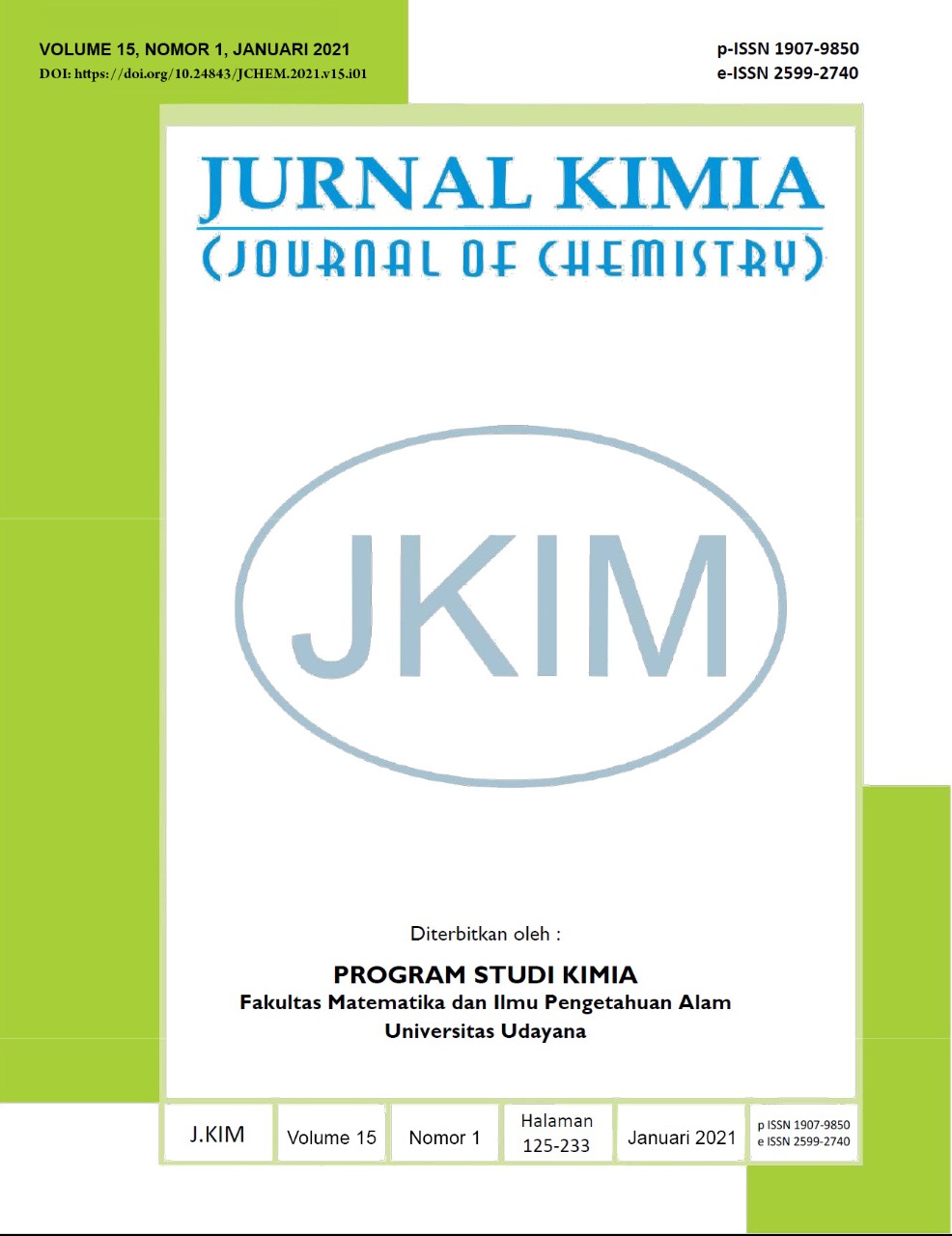KANDUNGAN LOGAM Cu TOTAL DALAM AIR LAUT DAN SEDIMEN SERTA BIOAVAILABELNYA DALAM SEDIMEN DI PANTAI BALANGAN KABUPATEN BADUNG BALI
Abstract
Pantai Balangan di Kabupaten Badung Bali adalah tujuan wisata yang sangat populer yang terletak di selatan Bali dekat Pura Uluwatu. Karena banyak sekali aktivitas wisata yang menimbulkan polusi. Tujuan penelitian untuk mengetahui konsentrasi logam Cu total dalam air dan sedimen serta untuk mengetahui bioavailabilitas Cu dalam sedimen. Untuk mengetahui bioavailabilitas Cu dalam sedimen, sedimen diekstraksi dengan metode ekstraksi sekuensial, kemudian filtrat dianalisis menggunakan Spektrofotometri Serapan Atom (SSA) merk Shimadzu AA-7000 dengan teknik kurva kalibrasi. Kandungan logam Cu yang diperoleh dalam air dan sedimen masing-masing adalah (0,0247-0,048) mg / L dan (3,2742-6,1334) mg / kg. Hasil fraksinasi Cu dalam sedimen adalah sebagai berikut: Fraksi EFLE (mudah, bebas, leachable dan dapat ditukar) sebesar 0,130 mg / kg - 0,787 mg / kg, fraksi Fe / Mn oksida 0,165 mg / kg - 0,819 mg / kg; organik / sulfida 0,456 mg / kg - 1,641 mg / kg dan fraksi resistansi 1,008 mg / kg - 3,478 mg / kg. Oleh karena itu, fraksi ketersediaan hayati dalam sedimen untuk Cu adalah 22,92% - 52,93%, dan fraksi resistansi adalah 47,06% - 77,06%, hal ini berarti bahwa terdapat sedikit Cu yang tersedia untuk organisme dibandingkan dengan resisten.
Kata kunci: air laut, bioavailabilitas, Cu, Pantai Balangan, sedimen
Balangan Beach located in Badung Regency of Bali is a very popular tourist destination in the south of Bali near Uluwatu Temple. There is a lot of tourism activities which can cause pollution. The aim of the study was to determine the concentration of total Cu metals in water and sediments as well as the bioavailability of Cu in the sediments. In order to determine the bioavailability of Cu in the sediments, the sediment was extracted by the sequential extraction method, then the filtrate was analyzed by using the Atomic Absorption Spectrophotometry (AAS) brand Shimadzu AA-7000 with a calibration curve technique. The metal content of Cu obtained in water and sediments was in the range of 0.0247-0.048 mg/L and 3.2742-6.1334 mg/kg, respectively. The results of Cu fractionation in sediments were as follows: EFLE fraction (easily, freely, leachable and exchangeable) was of 0.130 mg/kg – 0.787 mg/kg, Fe/Mn oxide fraction was of 0.165 mg/kg – 0.819 mg/kg; organic/sulfide was of 0.456 mg/kg – 1.641 mg/kg and the resistance fraction was of 1.008 mg/kg – 3.478 mg/kg. Therefore, the bioavailable fraction in the sediment for Cu was in the range of 22.92% - 52.93%, and the resistanct fraction was in the range of 47.06% - 77.06%.
Keywords: Balangan Beach, bioavailability, Cu, sea water, sediments
Downloads
References
Agustina, A., Sahara, E., and Dewi, I G. A. K. S. P. 2014. Spesiasi dan bioavailabilitas logam Cu dan Zn dalam sedimen dipelabuhan benoa yang diayak basah dan kering. Jurnal Kimia. 8 (1): 9-16
Arifin, Z., and Fadhlina. D., 2009. Fraksinasi Logam Berat Pb, Cd, Cu dan Zn dalam Sedimen dan Bioavailabilitasnya bagi Biota di Perairan Teluk Jakarta. ILMU KELAUTAN: Indonesian Journal of Marine Sciences. 14 (1): 27-32
Aryawan, R., Sahara, E., dan Suprihatin, I. E. 2017. Kandungan Logam Pb dan Cu Total dalam Air, Ikan dan Sedimen Di Kawasan Pantai Serangan Serta Bioavailabilitasnya, Jurnal Kimia. 11(1):56-63.
Boran, M., dan Altinok, I. 2010. A Review of Heavy Metals in Water, Sediment and Living Organisms in the Black Sea. Turkish Journal of Fisheries and Aquatic Sciences 10 : 565-572.
Connell dan Miller. 2006. Kimia Dan Ekotoksikologi Pencemaran, Universitas Indonesia Press, Jakarta.
Darmono. 1995. Logam Berat dalam Sistem Biologi Makhluk Hidup, UI-Press, Jakarta.
Darmono. 2001. Lingkungan Hidup Dan Pencemaran: Hubungannya dengan Toksikologi Senyawa Logam. Universitas Indonesia Press.
Davidson, C.M., Thomas, R.P., McVey, S.E., Perala, R., Littlejohn, D., dan Ure, A.M. 1994. Evaluation Of A Sequential Extraction Procedure For The Speciation Of Heavy Metals In Sediments. Analytica Chemica Acta, 291: 277-286.
Davidson, C.M., Duncan, A.L., Littlejhon, D., Ure, A.M., and Garden, L.M.1998. A Critical Evaluation of The Three-Stage BCR Sequential Extraction Procedure to Assess The Potential Mobility and Toxicity of Heavy Metals in Industially-Contaminated Land. Analityca Chimica Acta. 393(363): 45-44.
Gasparatos, D., Haidouti, C., Adrinopoulus dan Areta, O. 2005. Chemical Speciation And Bioavailabiliyy Of Cu, Zn and Pb In Soil From The National Garden Of Athens, Greece, Proceedings : International Conference On Environmental Science And Technology, Rhodes Island, Greece, 1-3 September 2005.
Siaka, M. 2016. Spesiasi dan Bioavailabilitas Logam Berat dalam Tanah dan Akumulasinya dalam Sayuran Sebagai dasar Penentuan Tingkat Aman Konsumsi. Disertasi. Pascasarjana Universitas Udayana, Falkutas Pertanian. Denpasar Bali.
Wardhana, W.A. 2004. Dampak Pencemaran Lingkungan. Cetakan keempat. Yogyakarta : Penerbit ANDI.
Wijayanti, N., Siaka, I. M., dan Widihati, I. A. G. 2015.Spesiasi dan Bioavailabilitas Logam Berat Timbal (Pb) dan Tembaga (Cu) dalam Sedimen Sungai Tukad Badung. Jurnal Kimia. 9(2):211-216.

This work is licensed under a Creative Commons Attribution 4.0 International License






